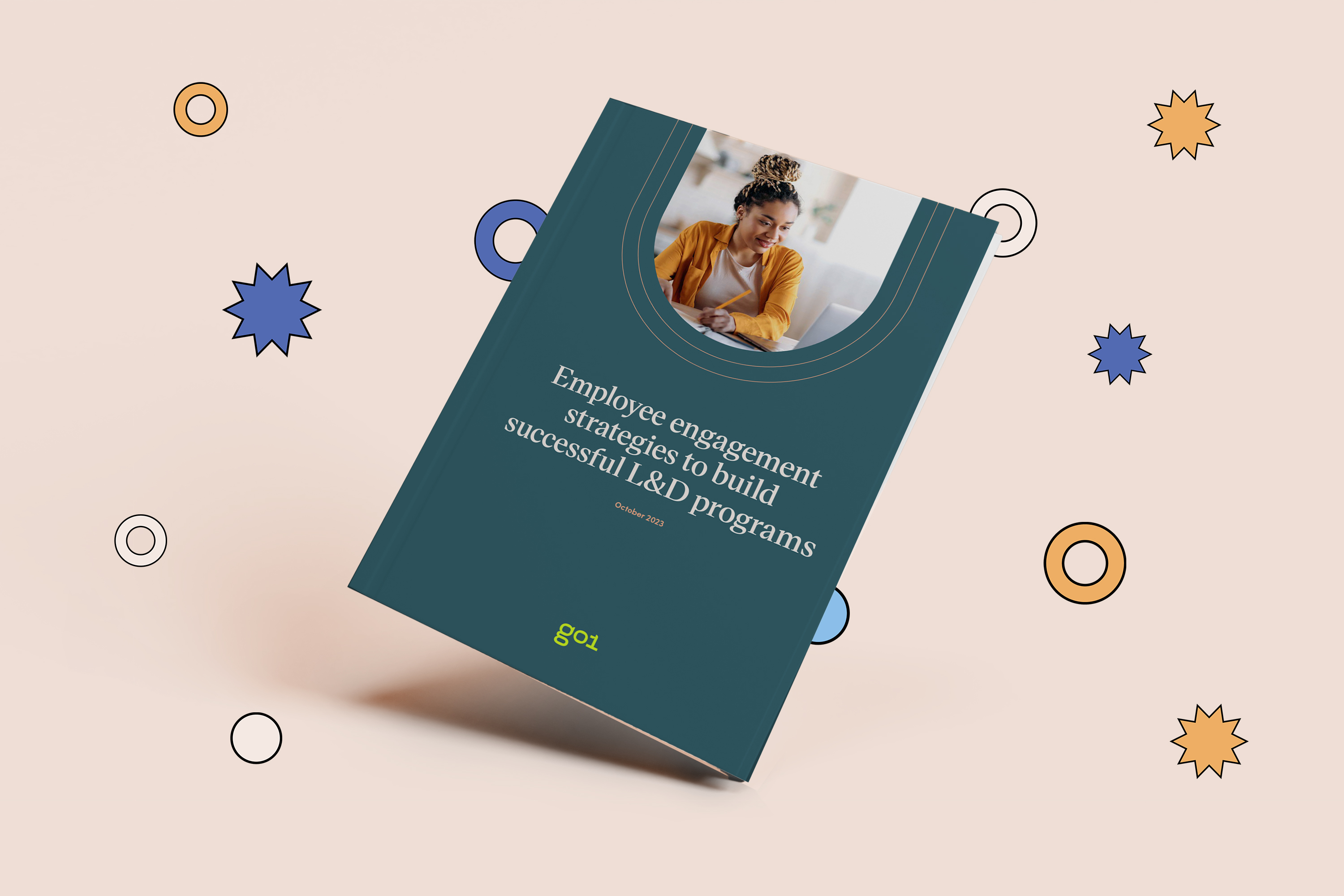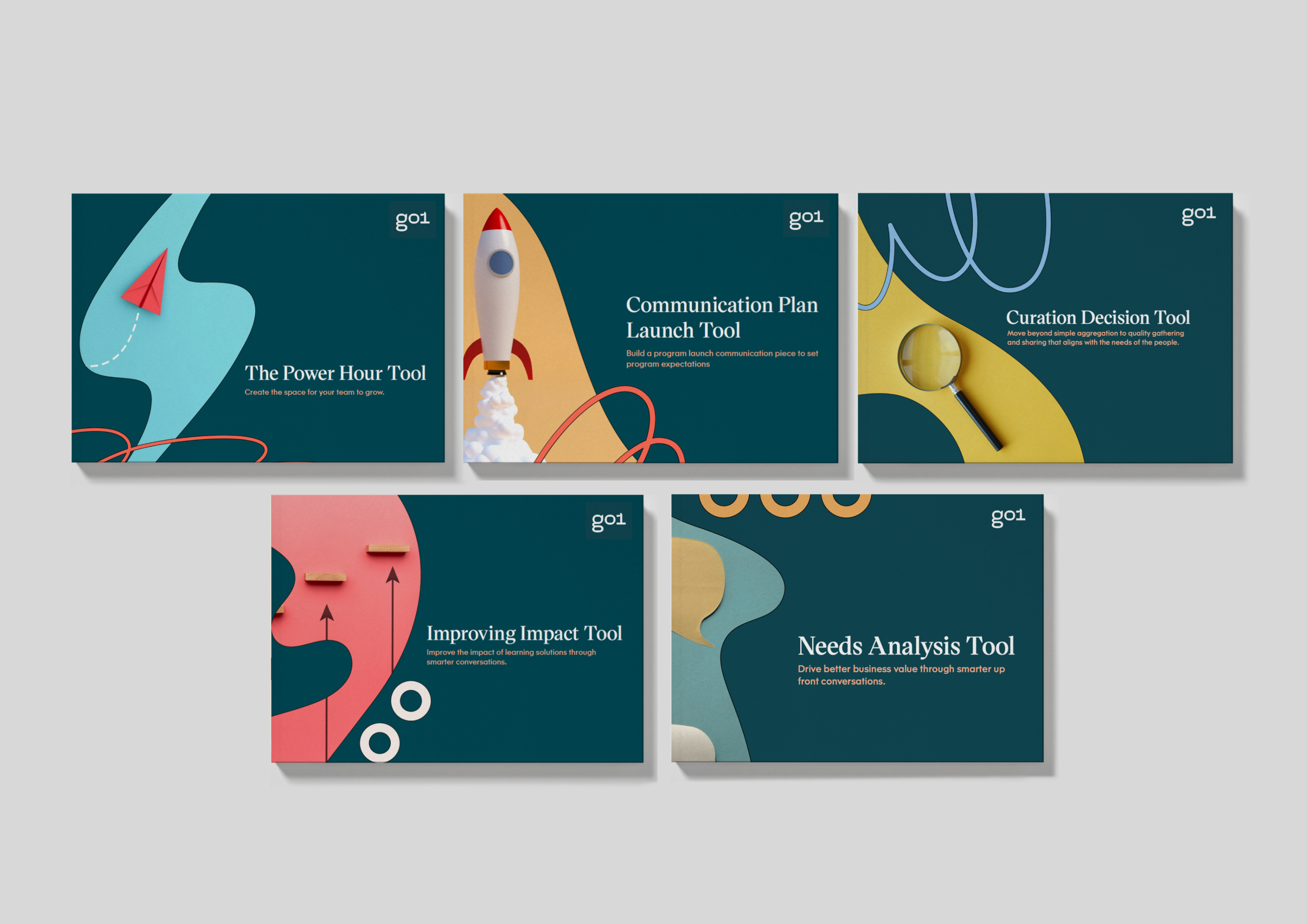
Employee engagement strategies to build successful L&D programs
Having a learning platform is one thing, building a successful L&D program is another thing entirely. So, the question becomes: how can I use my learning platform to build a successful L&D program?

Contents
Chapter 1: Igniting engagement
Benchmarking your learning engagement
Chapter 2: Fostering a culture of learning
Benefits of a learning culture
Five tips to foster a culture of learning
- Harness your leaders
- Create a community
- Put your learners in control with lifelong learning
- Implement a growth mindset to develop a culture of knowledge-sharing
- Focus on future-ready skills
Chapter 3: Empowering your learners
Introduction

Whether you want to learn a new language, master a recipe, or upskill employees, learning is a lifelong endeavor. This is as true for individuals as it is for organizations. The second you think your learning journey is complete is the second you start falling behind.
Accordingly, to have maximum impact, learning must be a continuous process, as discussed in our recent e-book, The ultimate buyer’s guide to choosing the right learning platform for your business.
However, having a learning platform is one thing, building a successful L&D program is another thing entirely. This knowledge differentiates industry leaders from everyone else. So, the question becomes: how can I use my learning platform to build a successful L&D program? Throughout this e-book, we’ll answer this question and many more to help set up your L&D program for long-term success.
To kick things off, in chapter one, we’ll examine how to engage your learners. Next, in chapter two, we’ll analyze how to foster a culture of learning. Finally, in chapter three, we’ll offer tips to empower your learners.
Ready to take the next step on your learning journey? Let’s get started.
Your L&D program will never reach its full potential without engaged learners. After all, there’s no point in having a learning platform if it sits on the shelf collecting dust. Luckily, when curated and communicated correctly, your learning library can be your secret weapon to igniting employee engagement.
Much like increasing ROI or retaining employees, boosting engagement is a goal every business shares. So, we’ll show you how to do exactly that, sharing tips and tricks to ignite engagement and set your L&D program up for ongoing success.

It should be no surprise that boosting employee engagement is a goal most HR departments share. According to SHRM, 87% of HR managers agree that improving employee engagement is one of their most important training goals. Despite this shared goal, 36% of talent developers say increasing employee engagement in learning is one of their biggest challenges. These stats tell a troubling story: most teams want to increase engagement, but few know how.
Luckily, there’s a solution: harnessing the power of your learning platform. Employees with access to the L&D they need are 21% more engaged than employees without adequate access to learning content. And that’s just the beginning.
That’s right — 92%. Employees almost unanimously agree that a well-planned L&D program increases their engagement. Similarly,
While 22% say L&D opportunities are essential when selecting or staying at a job. Millennials (80%) are most likely to value L&D opportunities when selecting or staying at a job, compared to 66% of Gen Z, 65% of Boomers, and 64% of Gen X.
Learner engagement is also a key indicator of high-impact learning cultures. According to Emerald Works:

No matter how you look at it, L&D has a massive impact on employee engagement. So, how do you ensure your learners are engaged so you can reap these benefits?

Ready for the next chapter?
Download the full e-book to discover:
- How to benchmark your learning engagement
- Tips for engaging learners
- The benefits of a learning culture
- How to empower your learners through self-directed learning
Some learners will naturally gravitate to your L&D program and engage from day one. Others may require a push in the right direction. For the latter, follow these three tips to engage learners and build a successful L&D program:
- Communication, communication, communication
Communication is vital to optimize engagement. You should regularly update your employees throughout the buying, implementation, and launch process for your learning platform, telling them everything they need to know about your L&D program. This may sound obvious, but failing to clearly explain your L&D offering to employees is a surprisingly common roadblock.
For example, 56% of employees only discover workplace learning programs via the employee intranet. You should communicate the benefits of your L&D program long before this stage. If your employees only discover your L&D program via the employee intranet after launch, it’s already too late. Worse, only 44% of employees hear about internal learning programs from their managers. In a well-prepared organization, this number should be close to 100%!
To prevent these communication breakdowns, you should continuously update managers and senior leaders throughout the buying process. Managers should then relay this information to employees.
Once you’re ready to launch, everyone in your organization should know when, where, and how they can access your new learning program. There should not be a single employee who learns about your L&D program for the first time after it launches!
Troublingly, 67% of leaders believe that the benefits of new tools and software are not adequately explained to employees, while 69% believe employees don’t have sufficient time to learn to use new tools. As a result, 80% of knowledge workers say they have frustrations with the learning tools their company provides.
Common frustrations with learning tools include:
- It only ticks a box for my company (30%)
- It’s boring (27%)
- It’s not personalized (24%)
- It takes too long to complete (24%)
- It doesn’t feel relatable or relevant (18%)
Here, a generational divide emerges, as millennials, Gen X, and baby boomers are all most likely to say that box-ticking is their biggest frustration, whereas Gen Z’s biggest frustration is that learning tools aren’t personalized. 22% of Gen Z learners believe most company training is out of date, while 25% complain that it’s boring or not personalized.
When sharing this news, you should also be mindful of not overwhelming employees, as 26% of employees say their workplace offers too much training, which can lead to analysis paralysis. Don’t leave your employees in the dark. It may sound obvious, but the best and easiest way to encourage engagement in your L&D program is by ensuring employees know it actually exists.
Further, 22% of teams say ensuring learners know where to find learning resources is one of their biggest challenges. Don’t fall into this trap. By the time you’re ready to launch your L&D program, your employees should know:
☑ The launch date (and, later, dates of any significant updates)
☑ Their login credentials
☑ Any new software they need to install
☑ What learning platform you selected
☑ Why you selected that particular platform (including key differences from your previous L&D program if applicable)
☑ Where to access your new L&D program (encourage learners to bookmark this page)
☑ Where they can use it (e.g., is it only accessible at work, or can employees learn on the go too?)
☑ Why they should use it, with a clear explanation of how it benefits them
☑ How to navigate the new platform (perhaps via a how-to guide or basic onboarding)
☑ What courses and learning providers they will have access to
☑ The type of learning they will have access to (e.g. text-based learning, microlearning, interactive quizzes, video content, etc.)
☑ Who else will be using it (seeing senior leaders use your learning program encourages buy-in)
☑ ...and everything in between.
2. Ensure employees have time to learn
Ensuring learners know about your L&D program is a great start. To build on this, you must also give learners enough time to use it. Unfortunately, this is another common pitfall. In today’s busy, hyper-competitive business landscape, many employees simply don’t have time for L&D. However, if you want to build a successful L&D program, this excuse doesn’t cut it — you must make time for learning.
Currently, the average employee only spends 24 minutes, or 1% of their time, learning in a typical week. 24 minutes! You probably spend more time switching between apps or looking for lost files.
What’s more, 61% of employees think time is the most significant barrier to their development, while 49% say they don’t have time to learn at work at all. Additionally, while 94% of workers see the benefit of making time for learning, just 49% actually make time to learn.
To break this down further, we found that 85% of knowledge workers dedicate some time engaging with L&D materials at work each month, spending an average of 4.3 hours per month. Similarly, 69% of knowledge workers spend time engaging with L&D materials outside of work each month, spending an average of 3 hours per month.
Of course, this is only the average, with 49% of knowledge workers saying they spend one hour or less engaging with L&D materials at work each month, and 64% saying they spend one hour or less engaging with L&D materials outside of work each month. Largely, this divide falls along generational lines, with 40% of baby boomers saying they spend no time each month engaging with L&D materials outside of work, compared to 31% of Gen X, 28% of millennials, and 26% of Gen Z. Inversely, Gen Z spends an average of 9.1 hours on learning per month at work, compared to 7.2 hours for millennials, 8.19 for Gen X and 6.48 for baby boomers.
Further, our research finds that short video content of less than three minutes is among the most popular forms of learning, with 42% of people saying this is their preferred training option. This preference for microlearning makes sense when time is such a factor. Millennials and Gen X (50% each) rank this as their preferred training method, while Gen Z (45%) and baby boomers (46%) still rank instructor-led training as their preferred learning method. Despite this, just 47% of companies offer short, microlearning-style video content.
Collectively, these stats show that people simply don’t have time to engage with workplace learning. These time constraints hold teams back, as when organizations dedicate time to learning, the results speak for themselves.
For example, Emerald Works found that 45% of managers are reluctant to make time for learning. However, among high-impact learning cultures (the top 10% of surveyed organizations), this figure drops to 21%. Therefore, giving your employees more time to learn can increase your overall impact.
Similarly, LinkedIn doubled their employees’ daily learning goal from 15 minutes to 30 minutes during their “Learning Challenge Week.” This increase led to 44% more engaged learners and 50% more course views. Consequently, even dedicating an extra 15 minutes per day to learning can have a massive impact.
The message is clear: you must actively carve out time for employees to learn. 24 minutes (or less) a week isn’t enough. If your employees have packed schedules with no time for L&D, that’s a problem. Whether it’s an hour on a Friday afternoon or 15 minutes every morning, you must allocate time where learning is your employees’ top priority. Emphasize that no one will be penalized for neglecting other tasks during this dedicated learning time. After all, what good is a learning platform if no one has time to use it?
3. Solicit feedback
Your employees know about your L&D program and have enough time to use it. Now, you need to fine-tune your approach by gathering feedback.
Again, many businesses neglect this vital step. In fact, 36% of employees say they either don’t have a feedback program at their company or aren’t aware of one. Concerningly, just 24% of employees say their company asks them for feedback as often as they’d like, while 22% say they never ask for feedback.
As a result, 39% of employees don’t feel heard by their organization. Yet, 78% of leaders believe they’re fostering a feedback culture. Here, a significant disconnect emerges — there is a sizable gulf between what leaders perceive and what employees experience! Employees are crying out for more opportunities to offer meaningful feedback.
These stats should ring alarm bells for senior leaders, as 41% of people have left a job because they didn’t feel listened to. On the other hand, employee turnover rates are 14.9% lower in companies that offer regular feedback, while 74% of employees say they are more effective when they feel heard.
So, how can companies reap these benefits? The State of Employee Feedback Survey finds the number one thing (68.4%) employees need to feel heard is for their company to take feedback seriously and implement meaningful change. Yes, it really is that simple.
Unfortunately, 40% of employees feel their feedback doesn’t lead to actionable change. As a result, many companies don’t collect honest, accurate feedback (if they collect feedback at all).
Instead, 43% of employees are more likely to tell leaders what they think they want to hear rather than how they actually feel.
Collecting feedback can be as simple as asking your employees what they think of your L&D program and whether they have any recommendations to improve it. It’s worth noting that some employees may feel more comfortable giving anonymous feedback, so this should also be an option.
Whatever your methodology, to build a successful L&D program, you must not only collect employee feedback but also implement meaningful changes based on that feedback. It really can be that easy. Whether it’s pointing out bugs or fine-tuning content recommendations, employee feedback is a vital tool to optimize your L&D program. After all, your employees are on the front lines, using your L&D program day in and day out, so they’re most suited to know how to improve it.
.png)
Don’t just take our word for it — many Go1 customers have experienced the benefits of increased engagement firsthand. For example, Dawn Stopha, Director of Global Programs at Fanatics said working with Go1 has decreased their attrition rate significantly.
Not only that, but Fanatics have also seen a marked increase in engagement since partnering with Go1. “Our team has seen a remarkable 75% increase in employee engagement since launching Go1. The content is engaging, it’s not boring. It’s content that energizes you,” Dawn added.
Jess Giudici, Director of Talent Management at Duravant echoed these sentiments. “We’ve had over 4,900 courses completed at a 71% completion rate, which is incredible. To see this level of engagement is amazing,” she said. Mandy Rutherford, L&D Manager at Wave Utilities, has also noticed a considerable increase in engagement thanks to Go1.
Ultimately, boosting learner engagement in your L&D program doesn’t have to be rocket science. It can be as straightforward as letting your learners know about your L&D program, ensuring they have time to use it, and fine-tuning your approach via feedback.
But that’s only the beginning. In chapter two, we’ll explain how you can take the leap from a handful of engaged learners to a company-wide culture of learning.
Engaging your learners is excellent. Keeping them engaged is another challenge entirely.
Consequently, fostering a culture of learning is vital to facilitate long-term engagement.
By fostering a culture of learning, workplace L&D can become self-sustaining. Learning becomes a habit. Before long, it will be second nature to your employees as they actively seek learning opportunities and encourage their peers to do the same.
Sounds fantastic, right? An organizational culture where everyone recognizes the value of learning and continuously seeks to update their knowledge. So, how do you achieve this goal? In this chapter, we’ll share everything you need to know to create a sustainable culture of learning.

The benefits of creating a culture of learning are manifold. According to Forbes, companies with strong learning cultures enjoy higher ROI on their training programs via increased productivity, as well as better retention rates and greater collaboration. And this is just the tip of the iceberg.
Companies with strong learning cultures are 92% more likely to be innovators. You might be wondering, how does this impact the bottom line? Well, such companies are also 17% more profitable than competitors.
Additionally, 76% of millennials believe professional development is one of the most important aspects of a company’s culture. Likewise, employees who work for companies that invest in learning resources are 83% more likely to be happy with their jobs.
Further, research by Docebo finds that high-performing organizations are 5x more likely to have an extensive learning culture. Top performers are also 3x more likely to leverage their learning culture in the recruitment process, showing that teams with entrenched learning cultures have a better chance of securing top talent.
With this in mind, it’s no surprise that “creating a culture of learning” is the third highest priority for L&D leaders, according to Linkedin’s 2023 Workplace Learning Report.
What company wouldn’t want that? Still, creating a culture of learning remains a significant challenge for many companies.
Research suggests only 10% of organizations have successfully created a productive learning culture, while just two in ten employees demonstrate effective workplace learning behaviors. Other estimates suggest that only 31% of people believe their company has a learning culture to a high or very high extent. Either way, this figure is startlingly low, so it’s no wonder 42% of L&D leaders say “building a culture of learning” is their top challenge.
As such, the benefits of fostering a culture of learning are clear. However, the path to achieving this can be ambiguous. Don’t worry, though – we’ll share some tips to help you create and maintain a sustainable learning culture.
.png)
Read the full e-book
Download the full e-book to discover:
- How to benchmark your learning engagement
- Tips for engaging learners
- The benefits of a learning culture
- How to empower your learners through self-directed learning
While fostering a sustainable learning culture is likely a high priority for your team, achieving this goal isn’t easy. Here are five practical tips to help you take the next step toward a sustainable learning culture.
![]()
1. Harness your leaders
Embedding a learning culture must start with your leaders. Why would employees take learning seriously if leaders don’t practice what they preach? You can’t have one set of rules for learners and another for leaders. Instead, leaders must set a good example and practice the same learning values they preach.
Why is this so important? Because high-performing organizations are 3x more likely to hold leaders accountable for demonstrating the importance of learning. Additionally, McKinsey finds that “good implementers were 1.4 times more likely than poor implementers to have change leaders who had personally led multiple change efforts.”
In other words, when leaders do their job and lead the way, others will follow.
![]()
2. Create a community
Now that your leaders are on board, the next step is to create a learning community. To successfully foster a culture of learning, L&D can’t just be an individual pursuit; it must be a shared experience.
92% of L&D pros agree that community-based learning fosters a sense of belonging. Similarly, 91% believe employees who learn together are more successful, while 86% say learning is more engaging when employees learn together.
Given this, it makes sense that 75% of L&D pros expect to see an increase in social learning initiatives in the coming year.
When creating a learning community, you must focus on inclusion and account for the strengths and weaknesses of all employees. For example, our research found that 88% of neurotypical workers say they collaborate well in person, compared to 73% of neurodivergent workers.
However, virtual collaboration levels the playing field; about the same number of neurodivergent (65%) and neurotypical (68%) workers say they collaborate well virtually.
By focusing on these areas and ensuring you include all learners, you are far more likely to create an effective, harmonious learning community.
Ready to turn your team into a learning community? Read our article on cultivating learning in workplace communities to get started.
![]()
3. Put your learners in control with lifelong learning
Learners are more likely to succeed when they have autonomy. Think about it: would you rather someone tell you what to learn, or listen to your needs and help you develop a personalized learning plan?
The stats back this up, as “allowing for personal choice in determining how work gets done” ranks second among the most important factors for sustainable workplace design.
It’s no wonder then that 93% of high-performing organizations agree that personalized learning helps employees reach professional goals more efficiently.
For further insights, read our blog on making the shift from formal education to lifelong learning and watch our webinar on learning in the flow of work.
![]()
4. Implement a growth mindset to develop a culture of knowledge-sharing
Mindset matters. A lot. As mentioned in our article on fixed mindsets vs growth mindsets, adopting a growth mindset opens up a world of possibilities for L&D teams — including embedding a sustainable learning culture.
High-performing learning cultures share knowledge 4x more than other organizations, meaning this should be a high priority. Additionally, 87% of HR managers agree that fostering a growth mindset is one of their most important L&D goals.
By adopting a growth mindset, you can remove communication barriers and develop a culture of knowledge sharing. The more you share knowledge, the more you learn, and the more your learning culture thrives!
![]()
5. Focus on future-ready skills
Having a good learning culture right now is fantastic, but developing a sustainable learning culture means planning for the future too. Creating a future-ready learning culture has become increasingly critical for L&D teams, as the shelf-life of skills is shrinking, forcing a wave of reskilling and a shift from hard skills to soft skills.
To underscore this point, 48% of L&D employees say their team is underskilled to deliver on key requirements for the future of their business. Therefore, L&D teams must focus on skills of the future to ensure their learning culture will be sustainable in the long run.
According to our research, younger generations are more likely to focus on industry retraining skills than baby boomers (19% of baby boomers, 24% of Gen X, 30% of Gen Z, and 31% of millennials). On the other hand, older generations receive more compliance training, with 54% of baby boomers saying they receive regular compliance training, compared to just 24% of Gen Z.
Yet, these numbers remain low across the board. Only 42% of knowledge workers receive training on skills related to their career progression, while just 26% of organizations conduct employee retraining or re-skilling to avoid layoffs. Further, 44% of workers say their organization doesn’t make the most of their potential for upskilling & growth.
In contrast, 41% want to learn new skills to fill in skill gaps to help future-proof their roles, while 11% say they want to learn new skills because they are worried their role might be phased out. Among younger workers, 40% of Gen Z and 41% of millennials are motivated to learn new skills to prepare for the next phase of their careers.
Again, a generational divide emerges. 48% of millennials and 45% of Gen Z say that higher salary potential motivates them to acquire new skills, compared to just 32% of baby boomers. Alternatively, 62% of baby boomers are motivated by general personal development, compared to just 38% of Gen Z.
AI is also a factor, with 45% of workers believing AI will help them develop future-ready skills more quickly. 51% of millennials and 49% of Gen Z believe this, compared to 41% of Gen X and 35% of baby boomers. Some even take this a step further, with 24% of workers saying generative AI is the only learning tool they need. On the other hand, 18% of workers are against using AI at all.
As such, using artificial intelligence will be a delicate balancing act for L&D teams going forward. AI may be a powerful tool for some, but it can turn other learners off entirely, meaning using AI will need to be evaluated on a learner-by-learner basis.
Unsure what skills your team will need in the future? Don’t worry, we cover that in detail in our article on closing the L&D skills gap.
Want to know how Go1 can help you create a culture of learning? Read our customer stories about how we helped SPARC Group and Metro Trains create learning cultures.
You’ve engaged your learners. You’ve laid the groundwork for a culture of learning to flourish. Now, to ensure your L&D program is as successful as possible, you must empower your learners. When employees have power and autonomy over their learning, your L&D program can transform from being employer-led — mandatory training that is forced upon employees — to employee-led, where employees actively seek learning opportunities.

To emphasize this point, our research found that 65% of employees feel empowered in their roles when offered training opportunities. Emerald Works reinforces these findings, explaining that “when we empower people to ‘own’ their learning journey and see how it adds value to them and their organization, we see increased levels of motivation, resilience, and performance.”
Additionally, agile learning organizations where “people engage with self-determined learning without prompting” are 11% more likely to enhance individual well-being, 24% more likely to produce a better-qualified workforce, 18% more likely to understand the principles of diversity and inclusion, and 12% more likely to increase on-the-job productivity.
This makes sense; after all, who wouldn’t prefer to personalize their learning rather than cycling through endless mandatory modules?
The good news is that the majority of workers (59%) feel empowered to ask for better learning & development programs that suit their needs. So, how do you empower your learners? We’ll analyze two key ways below.
.png)
What better way to empower learners than by encouraging them to direct their own learning? After all, who knows better how you want to learn: you, or a generic assigned learning program? Learners no longer want to sit back and be told what to learn; they want the freedom to access tools that facilitate learning. Ideally, at their own pace and on their own schedule.
Self-directed learning takes the onus off a central L&D strategy and puts it into learners’ hands, empowering them to set goals and access training in ways that complement their unique learning needs.
Notably, 96% of L&D professionals say increasing self-directed training opportunities is one of their top priorities. These figures make sense, as 77% of employees believe self-directed learning is more effective than their employer’s training. According to our research, 27% of people say that self-directed learning best prepared them for their current role, while 41% say self-directed learning is effective for giving workers new skills.
Further, LinkedIn finds that 43% of Gen Z, 42% of millennials, and 33% of Gen X and baby boomers want fully self-directed and independent learning. It’s never a bad time to give learners more of what they want.
The organizational benefits of self-directed learning are also vast. 50% of high-impact learning cultures provide opportunities for self-directed learning, compared to just 13% of “average” organizations.
Similarly, CIPD’s Towards Maturity report finds that “Top Deck” organizations (companies in the top decile of their Maturity Index) reported a 43% increase in self-directed learning opportunities.
Therefore, the more opportunities you provide for self-directed learning, the more likely you are to empower your learners and stand out as a top-performing, high-impact team.
To learn more, read our article on the benefits of self-directed learning.
.png)
Ready for the next chapter?
Download the full e-book to discover:
- How to benchmark your learning engagement
- Tips for engaging learners
- The benefits of a learning culture
- How to empower your learners through self-directed learning
If self-directed learning empowers employees to learn autonomously, focusing on diversity and inclusion empowers employees to be themselves. Few things are more empowering than knowing you can show up to work and be yourself.
On a human level, the benefits of a diverse workforce should be self-evident. Not only is supporting diversity the right thing to do, but it also leads to a greater array of experiences, ideas, and perspectives.
Thankfully, the statistics back this up. Companies with robust D&I programs are 22% more likely to be seen as industry leaders with high-caliber talent. Additionally, 58% of high-impact learning cultures embed the principles of diversity and inclusion into their daily work, compared to just 34% of other L&D teams. These figures show that a well-developed D&I program can take your L&D team to the next level.
Despite this, Neurodiversity Hub finds that 78% of neurodiverse people experience difficulties at their place of learning, with the main challenges being fitting in socially (60%), learning difficulties (55%), and communication difficulties (51%). To underscore this point, 49% of neurodivergent workers say their company doesn’t cater to different learning styles and needs.
Yet, when neurodiverse learners are empowered, the results can be immense. For example, a report by EY found that people with dyslexia often display the most in-demand skills for the workforce of the future – leadership, creativity, and initiative.
Similarly, Professor Rob Austin studied the best practices of companies with neurodiversity employment programs, explaining that teams who embrace neurodiversity in their recruitment process enjoy “an innovation benefit with these employees, because they think differently, ask different sorts of questions, and tend to trigger changes in the way companies do things.”
Even so, more than half (51%) of neurodivergent workers say their organization doesn’t make the most of their potential for upskilling & growth, compared to 42% of neurotypical workers who say the same.
To put this into practice and empower your learners, supporting diversity in digital learning means creating an environment that is equally accessible to all employees, regardless of their unique abilities or needs.
To learn more, read our article on how organizations can support neurodiversity in digital learning.
With these tools at your disposal, you should be well-equipped to build a successful, high-impact L&D program. Remember, going back to basics often reaps significant rewards.
Given this, engaging your learners is the best starting point to build a successful L&D program. After all, what’s the point of launching an L&D program if no one bothers to use it? Engaging learners will mean different things to different teams, depending on the nature of your learning program and your learners’ unique goals. However, to ensure maximum impact, you must communicate your L&D offering, dedicate time to learning, and solicit learner feedback. These tips may sound obvious, but too often, L&D programs fail because learners don’t know how to access them or don’t have enough time to use them. Don’t let your L&D program fail simply because your learners don’t know about it!
Once you have engaged your learners, it’s time to parlay this interest into building a culture of learning. By doing this, employees will remain engaged long-term as you unlock their love of learning and foster a culture where knowledge is power and learning is a cornerstone of your success.
Finally, you must empower your learners. This way, learning becomes self-sustaining, as learners actively seek content and own their learning journeys. By offering employees the freedom and autonomy to be themselves, set their learning goals, and learn at their own pace, you can transform from an L&D program where learning feels like a mandatory chore to a program where learning is its own reward.
Ultimately, with engaged, informed, and empowered learners, the sky’s the limit for your L&D program!








